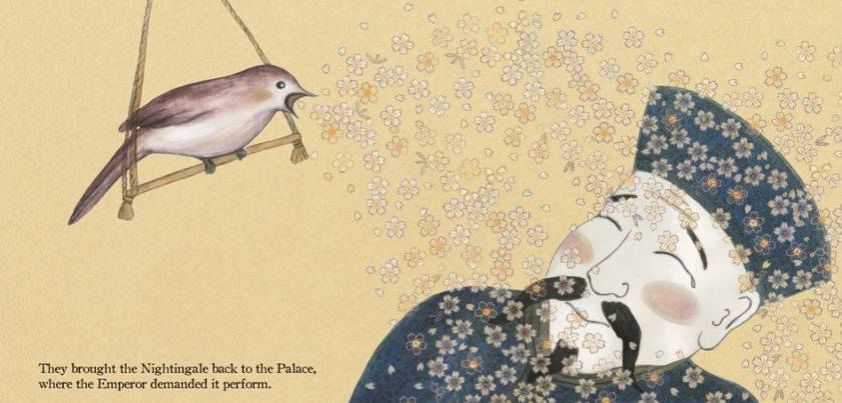 In this story by Hans Christian Andersen, a nightingale living near the palace of the Chinese Emperor sings so beautifully that it becomes famous all over the world. The Emperor loves the nightingale’s song so much that he makes a home for it in the palace. One day the Japanese Emperor sends him a mechanical bird covered in jewels that can sing as well as the nightingale. He replaces the live bird with the mechanical one, and does not come to appreciate the love of the real nightingale until close to death. Themes: artificial vs. natural beauty, friendship, betrayal, loyalty.
In this story by Hans Christian Andersen, a nightingale living near the palace of the Chinese Emperor sings so beautifully that it becomes famous all over the world. The Emperor loves the nightingale’s song so much that he makes a home for it in the palace. One day the Japanese Emperor sends him a mechanical bird covered in jewels that can sing as well as the nightingale. He replaces the live bird with the mechanical one, and does not come to appreciate the love of the real nightingale until close to death. Themes: artificial vs. natural beauty, friendship, betrayal, loyalty.
Original Text / PDF / Audio (3,538 words)
General Comments
If you live in a country that doesn’t have nightingales like I do, you can listen to the sound of one singing by clicking on the audio player below.
Our source for the story was the Project Gutenberg e-book Fairy Tales of Hans Christian Andersen. Two things surprised me in reading this early version of Andersen’s work. The first is the literary quality, much of which has been lost over the years as his stories have been re-written for children. The second is the dark themes and unhappy endings in many of the stories.
During his lifetime, Andersen rose from a poor family and difficult childhood to become one of the most famous writers in Europe. It is said that later in life he suffered from periods of depression, due in part to his childhood experiences and in part to frustrations in his adult life. Despite his wealth and success, he was never fully accepted in Danish high society because of his low beginnings. In addition, the only woman Andersen truly loved in his life did not return his feelings.
A lot of Andersen’s up and down emotions can be seen in his writing. This story and the famous children’s story The Ugly Duckling have heart-warming themes about how an animal that was badly treated because of how it looks can win out in the end. As a child, Andersen proved to be highly intelligent. However, people often laughed at him because he was also unusually tall, clumsy and ordinary looking. Could this be the source for the idea of the plain looking nightingale and ugly duckling?
These stories were both written in 1844. This was perhaps the happiest period of Andersen’s life, when he was courting Swedish opera singer Jenny Lind. The Nightingale was said to have been written as an expression of his love for her, earning her the nickname “The Swedish Nightingale”. This is perhaps why the nightingale in the story is female, when in fact it is the male bird that is famous for its song.
When Andersen wrote to Lind proposing marriage a year later, she wrote back politely saying “no” in the following words:
“farewell… God bless and protect my brother is the sincere wish of his affectionate sister, Jenny”.
Heartbroken, over the next two years Andersen wrote two of his saddest stories, also featured on our website: The Fir Tree and The Little Match Seller.
Video Version
This is an episode of The Fairytaler, a Danish animated television series based on the works of Hans Christian Andersen. The series was created in 1998 to celebrate Andersen’s 200th birthday and ran through to 2005. Watch and enjoy!
Radio Play Version
As the name suggests, radio plays are special versions of stories modified to make entertaining listening over the radio. Sometimes the stories will be changed slightly, and often extra dialogue is included to make the story fit the program’s required broadcast time.
This play is from the 1947 season of Let’s Pretend, a children’s radio theater series which ran on the CBS network from March 1934 until October 1954. The show always began with a characteristic jingle (short advertising song) from its sponsor, Cream of Wheat breakfast cereal. We have left this in at the beginning of the recording for atmosphere, but have edited out the childish talk by the announcers that followed it. The quality of the recording is not great, and the strong American accents of the actors don’t help in making us believe that the story really happened in China, but this is still a wonderful example of children’s entertainment in the days before TV.